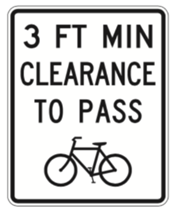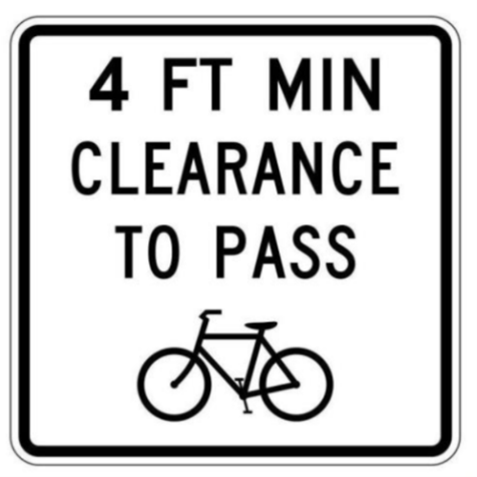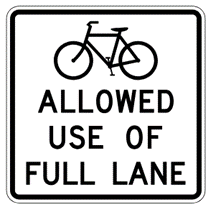This past December, the Federal Highway Administration (FHWA) released the 11th edition of the Manual on Uniform Traffic Control Devices for Streets and Highways (MUTCD). The MUTCD consists of national standards for traffic control devices, including street signage. Aside from some minor revisions, 14 years had passed since the last MUTCD was published.
NJ’s 4-foot Safe Passing Law
In 2022, New Jersey passed the “4-Foot Safe Passing Law.” This NJ Title 39 motor vehicle law stipulates that when passing bicyclists, pedestrians, and other vulnerable road users, drivers must first use caution when approaching, then slow their speed to 25 mph or stop if necessary and leave at least four feet of space between the individual and the vehicle when passing. This is a good step towards increasing safety for those who engage in active mobility when traveling. While other states have passed similar laws, there was previously no federal guidance on acceptable safe passing signs to use on public roadways. The updated MUTCD ensures that all states use the same clear signage. Since safe passing is now New Jersey law, the process of installing MUTCD-compliant signs to raise awareness is now underway.
New Regulatory Signs for Bicycles
The 11th edition of the MUTCD dedicates an entire section to traffic control for bicycle facilities (Part 9) and includes new signs that provide regulatory guidance on how drivers must interact with bicyclists on the roadway. One new sign reads “3 FT MIN CLEARANCE TO PASS” with a bicycle below the text. The MUTCD stipulates that the distance on this Bicycle Passing Clearance (R4-19) sign may be adjusted to match the applicable state law, which in New Jersey is four feet.

R4-19


R4-19 (NJ)

R9-20
“Share the Road” Signs
Another change in the new MUTCD is the removal of the “Share the Road” sign as an option. The “Share the Road” sign was eliminated from the MUTCD due to concerns that it was not effective in conveying a clear message to drivers. Researchers and critics challenged that the sign was ambiguous and did not provide specific guidance on how drivers should interact with bicyclists and other road users. As a result, sign options with clearer instructions are recommended instead. Signs such as “4-foot Minimum Clearance to Pass” (R4-19 NJ) and “(Bicycles) Allowed Use of Full Lane” (R9-20) are good options for replacement.
Sign Placement
The MUTCD placement guidance for the new “4-foot Minimum Clearance to Pass” sign expresses that these signs should not be placed next to bike lanes or bikeable road shoulders, rather placement should be prioritized in areas where limited bicycle infrastructure exists.
Middlesex County, NJ Supervising Engineer Michael Dannemiller, PE suggests that these signs could be placed along busier multi-lane roadways that lack bike lanes and wide, bicycle-friendly shoulders. “These signs might well reduce the chances of a bicyclist being injured in your jurisdiction,” says Dannemiller.
Other sources are available for sign placement guidance. The Urban Bikeway Design Guide, created by the National Association of City Transportation Officials (NACTO), emphasizes that signs are often placed at decision points such as intersections, where multiple bikeways meet, where bike lanes or other facilities intersect with a road, or at key locations along a route where bicyclists are more likely to travel (downtowns, parks, neighborhood connections, etc.).
What about Pedestrians and other Vulnerable Road Users?
The New Jersey Safe Passing Law was adopted to protect all road users who travel under their own power. Although the newly updated MUTCD includes other regulatory signs for pedestrians, the safe passing signage focuses solely on bicyclists. Proponents in New Jersey are exploring ways additional education, including signs, could address all vulnerable road users, including pedestrians and users of micromobility devices like e-bikes and e-scooters.
Resources
The New Jersey Bicycle and Pedestrian Resource Center’s website includes a flyer, PowerPoint, and other resources about New Jersey’s 4-foot Safe Passing Law. The New Jersey Bike & Walk Coalition hosts a Safe Passing Law Resource Center which offers information about the law, social media materials, educational resources, and a Safe Passing Pledge. By signing the pledge, individuals commit to supporting safe passing by slowing down, moving over, and giving vulnerable users plenty of space.
